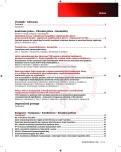Are we justified to classify patients with two unrelated clones with del(5q) and trisomy 8 as a subgroup of myelodysplastic syndrome of the type of 5q- syndrome?
Authors:
R. Neuwirtová 1; Z. Zemanová 2; J. Březinová 3; M. Beličková 3; P. Dvořák 4; A. Oltová 7; A. Jonášová 1; J. Čermák 3; D. Šponerová 3; J. Ullrichová 5; Z. Mašková 6; L. Červinek 7; Y. Smělíková 8; V. Vozobulová 9; E. Polonyová 10; M. Svoboda 11; K. Michalová 2
Authors‘ workplace:
I. interní klinika – klinika hematologie, Všeobecná fakultní nemocnice (VFN), 1. lékařská fakulta Univerzity Karlovy Praha
1; Centrum nádorové cytogenetiky, ÚLBLD, VFN Praha
2; Ústav hematologie a krevní transfuze Praha
3; Ústav lékařské genetiky, FN Plzeň
4; Oddělení klinické hematologie (OKH), Masarykova nemocnice Ústí nad Labem
5; OKH, Fakultní Thomayerova nemocnice Praha
6; Interní hematoonkologická klinika, FN Brno
7; OKH, Nemocnice Kroměříž
8; I. interní klinika, FN Plzeň
9; OKH, Nemocnice Karlovy Vary
10; OKH, Nemocnice Jindřichův Hradec
11
Published in:
Transfuze Hematol. dnes,20, 2014, No. 1, p. 25-31.
Category:
Comprehensive Reports, Original Papers, Case Reports
Overview
Among the 106 patients with myelodysplastic syndrome (MDS) of the type 5q minus syndrome, we found 11 patients who comply with the criteria of this syndrome. In addition to the del(5q) clone they were found to have the unrelated, independent trisomy 8 clone. All these patients were female. In ten patients, the del(5q) clone size was significantly larger than the +8 clone. The patients’ survival is long and no patient transformed into AML. Only one patient died; her +8 clone size was twice that of her del(5q) clone. Two of our patients are successfully being treated with lenalidomide, a drug with high efficiency in 5q- syndrome. Based on the clinical observation of our patients with both unrelated clones del(5q) and +8, we believe we can consider these patients as the subgroup of the 5q- syndrome and to expect the same favorable prognosis and similar efficacy of treatment as in the typical 5q- syndrome. Moreover, our results should remind hematologists that, when dealing with biclonality in MDS, it is necessary to assess the clones’ sizes, with the assumption that the larger clone will have a predominant effect on the prognosis. In patiens with clinical and laboratory symptoms of 5q- syndrome and trisomy 8 under “cut off value“ repeated cytogenetic examination is indicated.
Key words:
5q- syndrome, biclonality, del(5q)-trisomy 8
Sources
1. Van den Berghe H, Cassiman JJ, David G, et al. Distinct haematological disorder with deletion of long arm of no. 5 chromosome. Nature 1974; 251: 437-438.
2. Vardiman JW, Harris NL, Brunning RD. The world health organization (WHO) clasification of the myeloid neoplasms. Blood 2002; 100: 2292-2302.
3. Neuwirtová R, Jonášová A, Čermák J, et al. Analýza nemocných s myelodysplastickým syndromem (MDS) s delecí dlouhého ramene 5. choromozomu (del(5q)), sledovaných Českou MDS pracovní skupinou. Význam pro diagnostické zařazení a určení prognózy. Transfuze Hematol Dnes 2009; 15: 204-209.
4. List A, Dewals G, Bennett J, et al. Lenalidomide in the myelodysplastic syndrome with chromosome 5q deletion. N Eng J Med 2006; 355(14): 1456-1465.
5. Jonášová A. Myelodysplastický syndrom – pokrok v léčbě v 21. stolení. Vnitř Lék 2013; 59: 635-640.
6. Sloand EM, Mainwaring L, Fuhrer M. Preferential suppresion of trisomy 8 compared with normal hemopoietic cell growth by autologous lymphocytes in patients with trisomy 8 myelodysplastic syndrome. Blood 2005; 105: 841-851.
7. Heim S, Mitelman F. Cytogenetically unrelated clones in hematological neoplasms. Leukemia 1989; 3: 6-8.
8. Kobayashi H, Kaneko Y, Maseki N, Sakurai M. Karyotypical unrelated clones om acute leukemias and myelodysplastic syndromes. Cancer Genet Cytogenet 1990; 47: 171-178.
9. Musilová J, Michalová K, Zemanová Z, Březinová J. Multiple unrelated clones in myelodysplastic syndrome and in acute myeloid leukemia. Cancer Genet Cytogenet 1996; 88: 141-143.
10. Han JY, Kim KH, Kwon HC, et al. Unrelated clonal chromosome abnormalities in myelodysplasic syndromes and acute myeloid leukemias. Cancer Genet Cytogenet 2002; 132: 156-158.
11. Han JY, Theil KS, Hoeltge G. Frequencies and characterization of cytogenetically unrelated clones in various hematologic malignancies: seven years of experiences in a single institution. Cancer Genet Cytogenet 2006; 164: 128-132.
12. Heim S. Cytogenetic findings in primary and secundary MDS. Leuk Res 1992; 16: 43-46.
13. Pedersen-Bjergaard J, Timshel S, Andersen MK, et al. Cytogenetically unrelated clones in therapy-related myelodysplasia and acute myeloid leukemia: Experience from the Copenhagen series updated to 180 consecutive cases. Genes Chromosomes Cancer 1998; 23: 337-349.
14. Johansson B, Billström R, Broberg K, et al. Cytogenetic polyclonality in hematologic malignancies. Genes Chromosomes Cancer 1999; 24: 222-229.
15. Davidsson J, Paulsson K, Johansson B. Multicolor fluorescence in situ hybridization characterization of cytogenetically polyclonal hematologic malignancies. Cancer Genet Cytogenet 205; 163: 180-183.
16. Schanz J, Fischer S, Haferlach C, et al. Unrelated clones in myelodysplastic syndromes and acute myeloid leukemia – characterization and prognostic relevance. Abstract 4022. ASH Annual Meeting Abstracts 2010; 116: 1639.
17. Braulke F, Schanz J, Steffens R, et al. Two different del(5q) clones in a patient with myelodysplastic syndrome Leuk Lymphoma 2011; 52: 1811-1814.
18. Furuya T, Morgan R, Standberg AA. Cytogenetic biclonality in malignant hematologic disorders. Cancer Genet Cytogenet 1992; 62: 25-28.
19. Mallo M, Luno E, Sanzo C, et al. Clinical impact of the clone size in MDS cases with monosomy 7 or 7q deletion, trisomy 8, 20q deletion and loss of Y chromosome. Leuk Res 2011; 35: 834-836.
Labels
Haematology Internal medicine Clinical oncologyArticle was published in
Transfusion and Haematology Today

2014 Issue 1
Most read in this issue
- Toxoplasma and immunodeficiency
- TP53 deletion in patients with multiple myeloma and monoclonal gammopathy of undetermined significance - molecular cytogenetic analysis of 84 patients
- Are we justified to classify patients with two unrelated clones with del(5q) and trisomy 8 as a subgroup of myelodysplastic syndrome of the type of 5q- syndrome?
- Optimal process for searching for adult unrelated volunteer donors in unrelated donor registries
